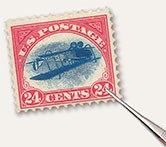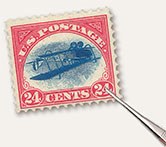⇚ Position 69 - 2024-06-14 Transaction Summary
Purchase Date:
2024-06-14
How Purchased:
Auction
Where Purchased:
Siegel Auction Galleries
Auction No.:
1323-The William H. Gross Collection
Lot No.:
91
Sound/Fault:
Sound
Catalogue Value:
$ 450,000
Realized:
$ 495,600
Seller:
Buyer:
Anonymous
Description
A beautiful, fresh example of the Inverted Jenny, the world’s most famous stamp rarity
DESCRIPTION
24¢ Carmine Rose & Blue, Center Inverted (C3a). Position 69, the ninth stamp in the seventh row of the sheet of 100 purchased by William T. Robey on May 14, 1918, original gum, lightly hinged, deep rich colors and extraordinary freshness, well-centered with wide margins, Very Fine and choice
PROVENANCE
William T. Robey, 5/14/1918, original purchase of the sheet of 100, sold to Klein for $15,000 (option executed 5/20/1918; delivered 5/21/1918)
Eugene Klein to Colonel Edward H. R. Green, ca. 5/20/1918, sale of the sheet for $20,000
Siegel Auction Galleries, 11/26/1969, Sale 362, lot 1265, to Weinberg
Siegel Auction Galleries, 8/27/1977, Sale 516, lot 1176
Siegel Auction Galleries, 2000 Rarities of the World, 5/13/2000, Sale 824, lot 346
Thomas C. McKinney, Shreves Philatelic Galleries, 9/13/2002, Sale 51, lot 290, to Hall
Robert R. Hall, Siegel Auction Galleries, 4/28-30/2015, Sale 1096, lot 818, to William H. Gross
CENSUS, LITERATURE AND EXHIBITION REFERENCES
World Stamp Show 2016 Court of Honor (Gross)
HISTORY AND COMMENTARY
The World’s Most Famous Stamp
The Inverted Jenny is the misprinted version of the 24¢ stamp issued especially for the start of the world’s first regularly scheduled mail service using airplanes. Airmail was inaugurated in the United States more than a century ago on Wednesday, May 15, 1918, in the midst of World War I and about 15 years after the Wright brothers achieved success with the first controllable, sustainable heavier-than-air flying machine at Kitty Hawk, North Carolina, on December 17, 1903.
The flights on May 15, 1918, marked the first attempt to fly civilian mail using winged aircraft on a regular schedule, which distinguishes this service from earlier official airmail carried on balloons or on airplanes used for short-term or restricted flights.
The original sheet of 100 Inverted Jenny errors was purchased by William T. Robey on May 14, 1918, the first day the stamps went on sale in all three principal airmail route cities: Washington, D.C., New York and Philadelphia. Robey bought the sheet for its $24 face value at the New York Avenue Post Office window in the District of Columbia. On Sunday, May 19, Robey agreed to give Eugene Klein, a prominent Philadelphia stamp dealer, a one-day option to buy the sheet for $15,000. Klein exercised his option on Monday, May 20, in a late afternoon phone call, and he confirmed it with a registered letter to Robey sent in the evening mail. The sheet was delivered to Klein’s office by Robey and his father-in-law on the following day, Tuesday, May 21, 1918.
No later than Monday, May 20, the day Klein exercised his option, he had arranged to sell the sheet for $20,000 to Colonel Edward H. R. Green. Half of the $5,000 profit went to Klein’s partners, Percy McGraw Mann and Joseph A. Steinmetz. Klein was then authorized by Colonel Green to divide the sheet into singles and blocks, and to sell all but a few key position blocks.
Despite the great rarity and value of Inverted Jenny stamps, many of the original hundred have been mistreated by collectors over the years. Colonel Green himself allowed moisture to affect some of the stamps he retained. Eight straight-edge copies that Klein was unable to sell and returned to Colonel Green were found in Green's estate stuck together in an envelope (they were soaked and lost their gum). Other examples have become slightly toned from improper storage and climatic conditions. Hinge removal has caused thins and creases in numerous stamps, and one was physically Scotch-taped to an exhibit page. Another was nearly lost to philately forever when it was swept up in a vacuum cleaner.
The stamp in the Gross collection is one of the freshest of the Inverted Jenny stamps. Its centering is choice for the sheet, and the gum is lightly hinged. Mr. Gross had acquired blocks of the Inverted Jenny, but after gifting them to his children, he found himself without a single for his album. In 2015, with the sale of the Robert R. Hall collection by Siegel, Mr. Gross found an opportunity to fill the blank space with Position 69.
DESCRIPTION
24¢ Carmine Rose & Blue, Center Inverted (C3a). Position 69, the ninth stamp in the seventh row of the sheet of 100 purchased by William T. Robey on May 14, 1918, original gum, lightly hinged, deep rich colors and extraordinary freshness, well-centered with wide margins, Very Fine and choice
PROVENANCE
William T. Robey, 5/14/1918, original purchase of the sheet of 100, sold to Klein for $15,000 (option executed 5/20/1918; delivered 5/21/1918)
Eugene Klein to Colonel Edward H. R. Green, ca. 5/20/1918, sale of the sheet for $20,000
Siegel Auction Galleries, 11/26/1969, Sale 362, lot 1265, to Weinberg
Siegel Auction Galleries, 8/27/1977, Sale 516, lot 1176
Siegel Auction Galleries, 2000 Rarities of the World, 5/13/2000, Sale 824, lot 346
Thomas C. McKinney, Shreves Philatelic Galleries, 9/13/2002, Sale 51, lot 290, to Hall
Robert R. Hall, Siegel Auction Galleries, 4/28-30/2015, Sale 1096, lot 818, to William H. Gross
CENSUS, LITERATURE AND EXHIBITION REFERENCES
World Stamp Show 2016 Court of Honor (Gross)
HISTORY AND COMMENTARY
The World’s Most Famous Stamp
The Inverted Jenny is the misprinted version of the 24¢ stamp issued especially for the start of the world’s first regularly scheduled mail service using airplanes. Airmail was inaugurated in the United States more than a century ago on Wednesday, May 15, 1918, in the midst of World War I and about 15 years after the Wright brothers achieved success with the first controllable, sustainable heavier-than-air flying machine at Kitty Hawk, North Carolina, on December 17, 1903.
The flights on May 15, 1918, marked the first attempt to fly civilian mail using winged aircraft on a regular schedule, which distinguishes this service from earlier official airmail carried on balloons or on airplanes used for short-term or restricted flights.
The original sheet of 100 Inverted Jenny errors was purchased by William T. Robey on May 14, 1918, the first day the stamps went on sale in all three principal airmail route cities: Washington, D.C., New York and Philadelphia. Robey bought the sheet for its $24 face value at the New York Avenue Post Office window in the District of Columbia. On Sunday, May 19, Robey agreed to give Eugene Klein, a prominent Philadelphia stamp dealer, a one-day option to buy the sheet for $15,000. Klein exercised his option on Monday, May 20, in a late afternoon phone call, and he confirmed it with a registered letter to Robey sent in the evening mail. The sheet was delivered to Klein’s office by Robey and his father-in-law on the following day, Tuesday, May 21, 1918.
No later than Monday, May 20, the day Klein exercised his option, he had arranged to sell the sheet for $20,000 to Colonel Edward H. R. Green. Half of the $5,000 profit went to Klein’s partners, Percy McGraw Mann and Joseph A. Steinmetz. Klein was then authorized by Colonel Green to divide the sheet into singles and blocks, and to sell all but a few key position blocks.
Despite the great rarity and value of Inverted Jenny stamps, many of the original hundred have been mistreated by collectors over the years. Colonel Green himself allowed moisture to affect some of the stamps he retained. Eight straight-edge copies that Klein was unable to sell and returned to Colonel Green were found in Green's estate stuck together in an envelope (they were soaked and lost their gum). Other examples have become slightly toned from improper storage and climatic conditions. Hinge removal has caused thins and creases in numerous stamps, and one was physically Scotch-taped to an exhibit page. Another was nearly lost to philately forever when it was swept up in a vacuum cleaner.
The stamp in the Gross collection is one of the freshest of the Inverted Jenny stamps. Its centering is choice for the sheet, and the gum is lightly hinged. Mr. Gross had acquired blocks of the Inverted Jenny, but after gifting them to his children, he found himself without a single for his album. In 2015, with the sale of the Robert R. Hall collection by Siegel, Mr. Gross found an opportunity to fill the blank space with Position 69.

.jpg)
.jpg)